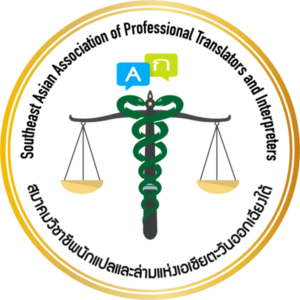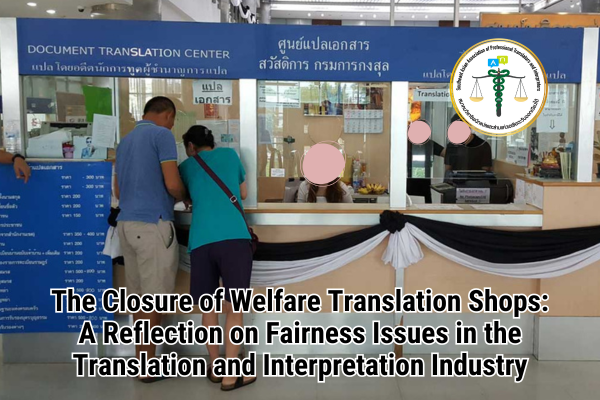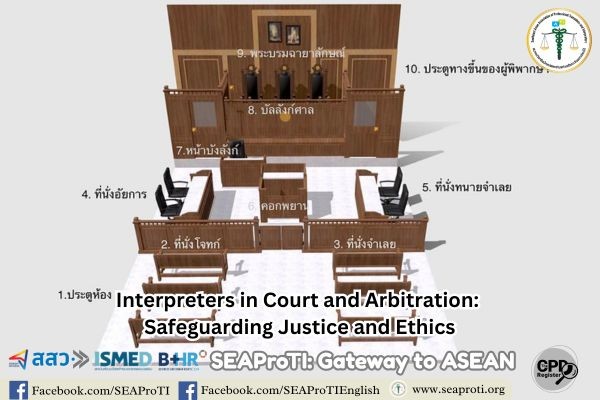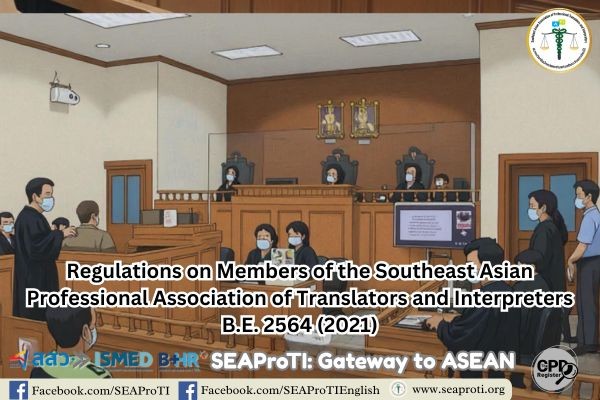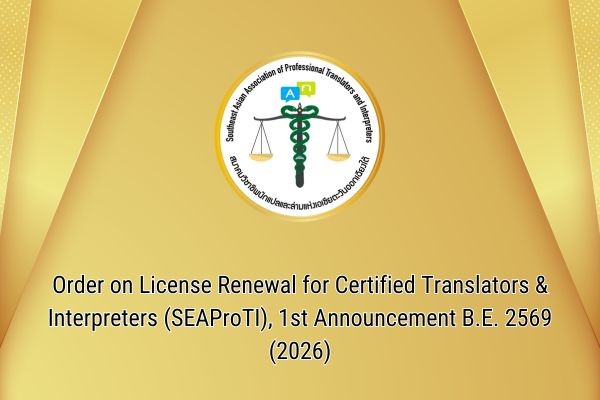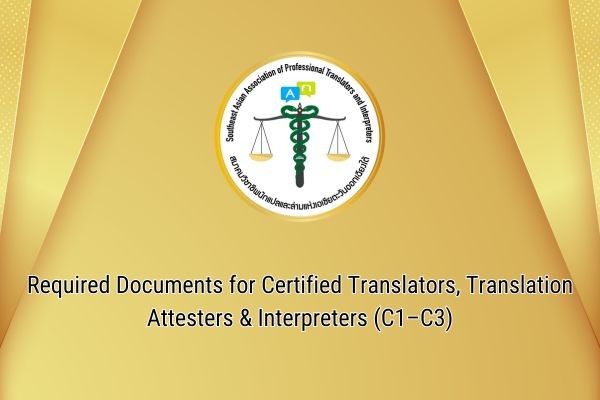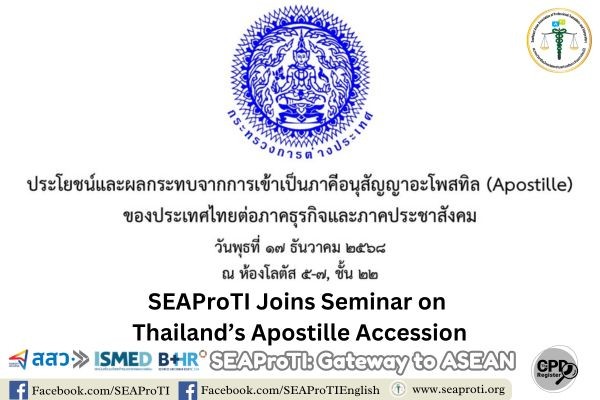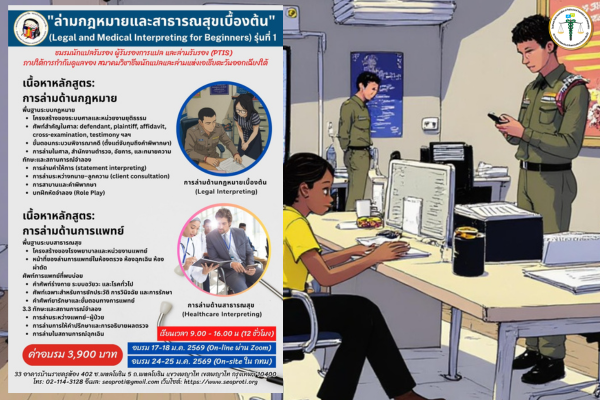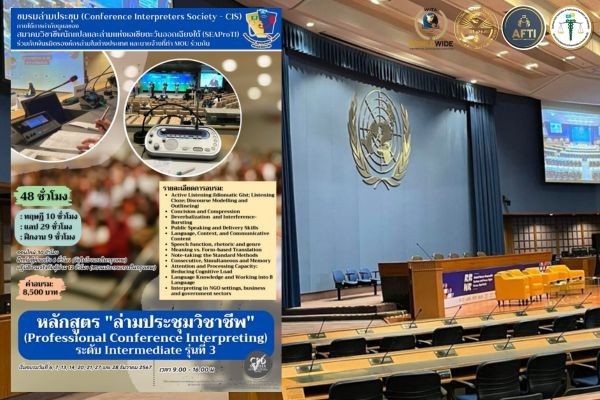AI and the Language of Gen Z: A Forensic Linguistics Perspective on Crime Prevention in the Digital Age
Author: Wanitcha Sumanat, president of the Southeast Asian Association of Professional Translators and Interpreters (SEAProTI) and SEAProTI- certified Forensic Linguist
2 November 2025, Bangkok – The Australian Federal Police (AFP) has recently developed an Artificial Intelligence (AI) system designed to understand and decode the “language of Generation Z.” This initiative represents a paradigm shift in digital policing, merging technology, linguistics, and criminology. The AI system is trained to interpret slang, emojis, and online symbols used in encrypted chats, gaming environments, and social media, communication spaces that have become central to youth interaction and, increasingly, to cyber-related criminal activity.
This development directly connects to the discipline of Forensic Linguistics, which studies how language functions within legal and criminal contexts. By teaching AI to analyze hidden meanings, coded expressions, and emotional tones, the AFP’s project integrates linguistic intelligence into digital law enforcement, turning online discourse into actionable intelligence for early crime prevention.
Relevance to Forensic Linguistics
Forensic linguistics extends beyond analyzing written or spoken words, it involves understanding context, intent, and discourse patterns. The AFP’s AI initiative mirrors this analytical process by focusing on the pragmatic and sociolinguistic dimensions of communication. Generation Z often employs dynamic and fast-changing language systems, including emojis, memes, and hybrid expressions, which can mask harmful or extremist intentions.
For example, a combination of emojis such as 🔫💀🔥 might not simply represent gaming symbols but could encode messages about violence or group identity. Traditional surveillance systems are ill-equipped to interpret these subtleties. Therefore, the AI’s linguistic model functions similarly to a forensic linguist detecting concealed meaning, inferring intent, and identifying potential threats based on discourse cues.
This approach transforms forensic linguistics from a post-crime analytical tool (examining evidence after an event) into a predictive model that can identify at-risk communication behaviors before crimes occur.
Linguistic Interpretation and AI Learning
The AFP’s AI system employs machine learning and natural language processing (NLP) to go beyond literal translation and capture contextual meaning. It learns from large datasets of online communication to identify tone, sentiment, and emerging patterns in youth language.
This aligns with Coulthard and Johnson’s (2017) assertion that forensic linguistics is fundamentally about context and intention rather than simple word matching. By incorporating contextual semantics, sociolinguistic variation, and pragmatic inference, AI can better recognize when ordinary digital expressions signal distress, radicalization, or grooming.
In essence, the AFP’s model demonstrates how AI-assisted forensic linguistics can evolve from text analysis into an interpretive science — one that understands language as a living social system rather than a static code.
Social Benefits and Ethical Considerations
The societal impact of this project is profound. By decoding the online communication of at-risk individuals, law enforcement can intervene earlier in cases involving cyberbullying, sexual exploitation, or extremist recruitment. This approach embodies the principle of preventive justice, using linguistic signals to safeguard potential victims — particularly children and teenagers.
Moreover, the system’s ability to detect early signs of manipulation or self-harm may contribute to public safety and mental health awareness. As the AFP Commissioner remarked, “If it once took a village to raise a child, it now takes a nation to protect them.”
Nevertheless, such initiatives raise critical ethical and privacy concerns. Constant linguistic surveillance risks infringing on digital rights and freedom of expression. Thus, the use of forensic linguistics in AI must be guided by strict ethical frameworks ensuring proportionality, accountability, and human oversight.
Conclusion: The Convergence of AI and Forensic Linguistics
The AFP’s project exemplifies the emergence of AI-driven forensic linguistics — a fusion of computational power and linguistic expertise. It demonstrates that understanding the language of youth is not merely a sociocultural exercise but a security imperative in the digital era.
Ultimately, the goal is not surveillance for its own sake but understanding — building safer online communities through linguistic empathy and informed prevention. By decoding the evolving symbols of Gen Z, law enforcement gains insight into the digital psyche of the new generation, turning communication itself into a tool for protection rather than harm.
References (APA 7th Edition)
- Coulthard, M., & Johnson, A. (2017). An Introduction to Forensic Linguistics: Language in Evidence (2nd ed.). Routledge.
- Grant, T. (2022). Quantitative Methods in Forensic Linguistics: An Introduction. Routledge.
- Holt, E., & Johnson, A. (2023). Forensic linguistics and artificial intelligence: Emerging tools in law enforcement. Journal of Language and Law, 10(2), 145–162.
- Australian Federal Police (AFP). (2025, October). AI system for decoding Gen Z language in cybercrime prevention. Canberra: AFP Press Office.
About Certified Translators, Translation Certifiers, and Certified Interpreters of SEAProTI
The Southeast Asian Association of Professional Translators and Interpreters (SEAProTI) has formally announced the qualifications and requirements for registration of Certified Translators, Translation Certification Providers, and Certified Interpreters in Sections 9 and 10 of the Royal Gazette, published by the Secretariat of the Cabinet, Office of the Prime Minister of Thailand, on 25 July 2024 (Vol. 141, Part 66 Ng, p. 100). Certified Translators, Translation Certification Providers, and Certified Interpreters
The Council of State has proposed the enactment of a Royal Decree, granting registered translators and recognized translation certifiers from professional associations or accredited language institutions the authority to provide legally valid translation certification (Letter to SEAProTI dated April 28, 2025)
SEAProTI is the first professional association in Thailand and Southeast Asia to implement a comprehensive certification system for translators, certifiers, and interpreters.
Head Office: Baan Ratchakru Building, No. 33, Room 402, Soi Phahonyothin 5, Phahonyothin Road, Phaya Thai District, Bangkok 10400, Thailand
Email: hello@seaproti.com | Tel.: (+66) 2-114-3128 (Office hours: Mon–Fri, 09:00–17:00)
วิเคราะห์เชิงภาษาศาสตร์นิติวิทยาศาสตร์ต่อโครงการ AI ของตำรวจออสเตรเลีย
ผู้แต่ง วณิชชา สุมานัส นายกสมาคมวิชาชีพนักแปลและล่ามแห่งเอเชียตะวันออกเฉียงใต้ และผู้เชี่ยวชาญด้านนิติภาษาศาสตร์
2 พฤศจิกายน 2568, กรุงเทพมหานคร – การพัฒนาเครื่องมือ AI โดยหน่วยงานตำรวจสหพันธ์ออสเตรเลีย (Australian Federal Police: AFP) เพื่อเรียนรู้ “ภาษาของคน Gen Z” ถือเป็นความเคลื่อนไหวสำคัญในแนวคิดการบังคับใช้กฎหมายเชิงภาษาศาสตร์ยุคดิจิทัล โครงการนี้มุ่งให้ AI สามารถเข้าใจและตีความ “รหัสทางภาษา” ที่เยาวชนใช้สื่อสารกันบนแพลตฟอร์มออนไลน์ เช่น คำแสลง อิโมจิ สัญลักษณ์ และโครงสร้างภาษาที่ไม่เป็นทางการ เพื่อใช้ตรวจจับสัญญาณพฤติกรรมเสี่ยงก่อนจะพัฒนาเป็นอาชญากรรมจริง
ความเคลื่อนไหวดังกล่าวมีความเกี่ยวข้องโดยตรงกับ Forensic Linguistics (ภาษาศาสตร์นิติวิทยาศาสตร์) ซึ่งเป็นสาขาที่ศึกษาภาษาในบริบททางกฎหมาย การสืบสวน และการพิสูจน์หลักฐานทางภาษาศาสตร์ โครงการของ AFP จึงเป็นตัวอย่างที่โดดเด่นของการบูรณาการเทคโนโลยี AI เข้ากับการวิเคราะห์เชิงภาษาศาสตร์ เพื่อเพิ่มศักยภาพในการป้องกันอาชญากรรมออนไลน์ที่ซับซ้อนและเปลี่ยนแปลงรวดเร็ว
ความเกี่ยวข้องกับภาษาศาสตร์นิติวิทยาศาสตร์
ในทาง Forensic Linguistics การวิเคราะห์ภาษาไม่ได้จำกัดอยู่ที่ถ้อยคำที่เขียนหรือพูดเท่านั้น แต่รวมถึงการตีความ “บริบทของการใช้ภาษา” (contextual meaning) ซึ่งอาจสื่อความนัยที่ซ่อนเร้น การฝึก AI ให้เข้าใจภาษา Gen Z จึงเป็นการจำลองกระบวนการคิดแบบนักภาษาศาสตร์นิติวิทยาศาสตร์ ที่สามารถแยกแยะระหว่างภาษาธรรมดากับภาษาที่แฝงเจตนาอันตราย เช่น การยุยง การล่วงละเมิด หรือการสื่อสารเพื่อก่ออาชญากรรม
ในอดีต นักภาษาศาสตร์นิติวิทยาศาสตร์ใช้การวิเคราะห์ข้อความเพื่อระบุตัวผู้เขียน (author identification) หรือถอดรหัสความหมายในข้อความข่มขู่ (threat analysis) แต่ในยุคดิจิทัล ภาษาของเยาวชนได้เปลี่ยนไปอย่างรวดเร็ว เกิดการใช้ อิโมจิ (emoji semiotics) และ คำแสลง (slang codes) เป็นสัญญะใหม่ในการสื่อสาร เช่น 🔫💀🔥 อาจไม่ได้หมายถึงการเล่นเกมเท่านั้น แต่ยังอาจแฝงนัยของความรุนแรงหรือการคุกคาม
ดังนั้น โครงการของ AFP จึงสะท้อนการต่อยอดแนวคิดภาษาศาสตร์นิติวิทยาศาสตร์จาก “การวิเคราะห์หลังเหตุการณ์” (post-crime analysis) สู่ “การวิเคราะห์เชิงคาดการณ์” (predictive linguistic analysis) โดยใช้ AI เป็นผู้ช่วยในการถอดรหัสสัญญาณทางภาษาที่อาจบ่งชี้ถึงพฤติกรรมเสี่ยง
การตีความทางภาษาและการเรียนรู้ของ AI
AI ที่ฝึกโดย AFP ใช้เทคนิคการเรียนรู้ของเครื่อง (machine learning) เพื่อเข้าใจ “บริบท” มากกว่าการแปลตรงตัว เช่น
- การวิเคราะห์ความหมายของคำหรืออิโมจิในบริบทของเกมหรือโซเชียล
- การแยกแยะน้ำเสียง (tone) และอารมณ์ (sentiment) ในการสื่อสาร
- การระบุรูปแบบของการสื่อสารที่อาจชี้นำสู่การล่วงละเมิดหรือความรุนแรง
แนวทางนี้สอดคล้องกับแนวคิดของ Coulthard และ Johnson (2017) ที่ชี้ว่า ภาษาศาสตร์นิติวิทยาศาสตร์เป็นศาสตร์แห่ง “บริบทและเจตนา” ไม่ใช่เพียงการจับคู่คำกับความหมาย การให้ AI เรียนรู้ภาษาเยาวชนจึงเป็นการเสริมศักยภาพให้ระบบสามารถ “เข้าใจภาษามนุษย์ในเชิงสังคม” ซึ่งเป็นหัวใจของการตีความในงานนิติภาษาศาสตร์
ประโยชน์ทางสังคมและจริยธรรม
จากมุมมองทางสังคม โครงการนี้มีประโยชน์ต่อการ ป้องกันอาชญากรรมก่อนเกิดเหตุ (crime prevention) โดยเฉพาะการล่วงละเมิดทางเพศ การกลั่นแกล้งออนไลน์ และการยุยงให้เกิดความรุนแรง ซึ่งมักเริ่มจากบทสนทนาในโลกออนไลน์
การที่ AFP สามารถถอดรหัสและตรวจจับได้ตั้งแต่ระยะเริ่มต้น อาจช่วยชีวิตเหยื่อและลดความเสียหายได้อย่างมาก โครงการยังช่วยสร้าง “ภูมิคุ้มกันดิจิทัล” ให้กับสังคม เพราะการเข้าใจภาษาของเยาวชนคือการเข้าใจโลกของพวกเขา
อย่างไรก็ตาม นักภาษาศาสตร์และนักจริยธรรมได้ตั้งคำถามถึง ขอบเขตของการเฝ้าระวังทางภาษา ว่าควรคงไว้ในระดับใดเพื่อไม่ให้ละเมิดสิทธิส่วนบุคคล การนำ AI มาใช้ใน forensic linguistics จึงต้องอาศัยกรอบจริยธรรมและการตรวจสอบโดยผู้เชี่ยวชาญ เพื่อให้สมดุลระหว่าง “การคุ้มครองสังคม” กับ “การคุ้มครองสิทธิของบุคคล”
บทสรุป: จุดบรรจบของ AI และภาษาศาสตร์นิติวิทยาศาสตร์
กรณีของ AFP เป็นหลักฐานว่า ภาษาศาสตร์นิติวิทยาศาสตร์กำลังก้าวสู่ยุคของ AI-assisted Forensic Linguistics ที่ระบบสามารถช่วยวิเคราะห์ข้อมูลภาษามหาศาลได้อย่างรวดเร็วและแม่นยำ ทั้งนี้ยังยืนยันว่า “ภาษา” ยังคงเป็นหลักฐานสำคัญที่สุดในการเข้าใจพฤติกรรมมนุษย์
การฝึก AI ให้เข้าใจภาษา Gen Z ไม่ได้มีเป้าหมายเพียงเพื่อสอดแนมหรือจับกุม แต่เพื่อ “เข้าใจ” เยาวชน และสร้างสังคมออนไลน์ที่ปลอดภัยขึ้น ซึ่งเป็นภารกิจร่วมของทั้งภาษาศาสตร์ นิติวิทยาศาสตร์ เทคโนโลยี และมนุษยธรรม
เอกสารอ้างอิง (References)
- Coulthard, M., & Johnson, A. (2017). An Introduction to Forensic Linguistics: Language in Evidence (2nd ed.). Routledge.
- Grant, T. (2022). Quantitative Methods in Forensic Linguistics: An Introduction. Routledge.
- Holt, E., & Johnson, A. (2023). “Forensic Linguistics and Artificial Intelligence: Emerging Tools in Law Enforcement.” Journal of Language and Law, 10(2), 145–162.
- Australian Federal Police (AFP). (2025, October). AI System for Decoding Gen Z Language in Cybercrime Prevention. Canberra: AFP Press Office.
สมาคมวิชาชีพนักแปลและล่ามแห่งเอเชียตะวันออกเฉียงใต้ (SEAProTI) ได้ประกาศหลักเกณฑ์และคุณสมบัติผู้ที่ขึ้นทะเบียนเป็น “นักแปลรับรอง (Certified Translators) และผู้รับรองการแปล (Translation Certification Providers) และล่ามรับรอง (Certified Interpreters)” ของสมาคม หมวดที่ 9 และหมวดที่ 10 ในราชกิจจานุเบกษา ของสำนักเลขาธิการคณะรัฐมนตรี ในสำนักนายกรัฐมนตรี แห่งราชอาณาจักรไทย ลงวันที่ 25 ก.ค. 2567 เล่มที่ 141 ตอนที่ 66 ง หน้า 100 อ่านฉบับเต็มได้ที่: นักแปลรับรอง ผู้รับรองการแปล และล่ามรับรอง
สำนักคณะกรรมการกฤษฎีกาเสนอให้ตราเป็นพระราชกฤษฎีกา โดยกำหนดให้นักแปลที่ขึ้นทะเบียน รวมถึงผู้รับรองการแปลจากสมาคมวิชาชีพหรือสถาบันสอนภาษาที่มีการอบรมและขึ้นทะเบียน สามารถรับรองคำแปลได้ (จดหมายถึงสมาคม SEAProTI ลงวันที่ 28 เม.ย. 2568)
สมาคมวิชาชีพนักแปลและล่ามแห่งเอเชียตะวันออกเฉียงใต้ เป็นสมาคมวิชาชีพแห่งแรกในประเทศไทยและภูมิภาคเอเชียตะวันออกเฉียงใต้ที่มีระบบรับรองนักแปลรับรอง ผู้รับรองการแปล และล่ามรับรอง
สำนักงานใหญ่: อาคารบ้านราชครู เลขที่ 33 ห้อง 402 ซอยพหลโยธิน 5 ถนนพหลโยธิน แขวงพญาไท เขตพญาไท กรุงเทพมหานคร 10400 ประเทศไทย
อีเมล: hello@seaproti.com โทรศัพท์: (+66) 2-114-3128 (เวลาทำการ: วันจันทร์–วันศุกร์ เวลา 09.00–17.00 น.)

